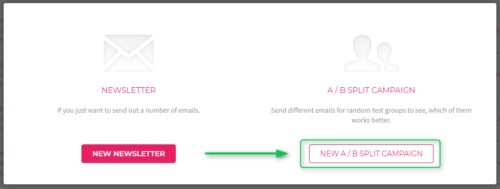You may have heard the phrases split and A/B testing or multivariate testing before. Sure, these words can resemble some complicated scientific terms, and, for many entrepreneurs or small businesses, these phrases may look like something too challenging even to try. However, we are here to show you that A/B testing is actually not too complicated. We will discuss why A/B testing is beneficial and why it’s worth adding to your marketing plans.

What Is A/B Testing, And What Does It Have To Do With Your Emails?
Simply put, A/B testing is a way to test different variables or elements in one email campaign. You can call it split testing too. Multivariate testing is used when you have a higher number of variations. Nowadays, A/B testing your emails is a popular and encouraged practice, and it’s also used across other digital mediums.
For example, when creating an email template, you cannot decide whether you prefer a bright orange call-to-action (CTA) button or a light blue one, as they both look great. That’s where A/B testing comes in – it will allow you to try both CTAs in one email campaign.
Randomly generated test groups created from your mailing lists will receive different versions of your email. In other words, some people will get an email with your orange button, and others will get one with a blue CTA.
This way, you will be able to evaluate which button was more successful – in this case, the orange or the blue call-to-action. You can A/B test manually, but it would be quite a time-consuming process. Therefore, you need to have a tool that can help you. We offer our clients an automated way to A/B test when using our Smaily platform.
Remember, you can test many things – the subject lines, the sender names, the length of your email, the preheaders, the images (you can read more about the visual elements in emails here), and many other features.
A/B Test Your Emails: Find Ways To Connect With Your Clients
If you want to be successful, you need to build relationships with your audience and, as a result, sell your products or services or accomplish other goals you have set. You need to find ways to connect with your clients. And the best way to do it is to try and see what they like, one step at a time, one test at a time.
So where do you start? First of all, make a plan, don’t just begin testing for the sake of it. Think about the different email elements you want to try and the reasons behind them. What do you want to achieve? For example, you could aim to determine the potential variables that can influence your open rates. An excellent way to begin is to test your subject lines.
After you select your test variables, it is best to analyze your choice further to create a more comprehensive test plan. In our set example, we have decided that we would like to try different subject lines. Thus, we have multiple choices – long versus short subject lines, a question against a statement, or maybe even adding an emoticon to our subject line. All these alterations may have a different impact on your open rates. However, ensure you don’t mix all of them in one test. Be precise and plan it well. Moreover, use similar tests several times to watch for trends and forming patterns.
It is even better if you can segment your mailing list accordingly. You may find out that people from one country prefer informative subject lines. Or you may discover that a particular age group might positively react to emoticons used in your subject lines.

Don’t Get Confused: Make A Clear Plan
It is imperative that once you start your tests, you don’t lose track of what you’re testing and why. Having a clear A/B testing plan and a result sheet is very important. Otherwise, after a few tests, you may get some mixed results and might lose track of which element you used in which test and what impact you saw. It could get confusing!
Make a spreadsheet or a Word document, or, if you prefer, a pen and paper – write down your results. Describe all the crucial details, including:
- the time of day
- the day of the week
- the month
- the elements tested
- the email type
- the reasons behind the test (your goals)
- the audience selected (specific mailing list segments, such as age, location, etc.)
- your results
- other comments indicating the potential impact on your test results (e.g., holiday season, big news announcement, etc – all these external factors can also influence your email results).

Key To Success: Analyse And Optimise
Once you have collected enough data, look at your findings again. Try to form patterns and spot the trends. The more test data you gather, the better the insight you get. Maybe you’ll see that in certain months your open rates increase if you use emoticons in your subject line – this, for example, could coincide with a holiday.
If you’re an Excel guru, you can put these results in a table and create graphs and charts that will help you visualize the fluctuations better.
Each test can give you ideas on improving your email campaigns – see what made your emails more successful. Optimize your email templates and your email content accordingly – use the insight you get.
We Made A/B Testing Easy
We here at Smaily, love A/B testing. Thus, we’ve made it easy for you to try it yourself! All you need to do is click on that A/B split campaign button and start from there.

Not sure what to do next? Click here to find a step-by-step guide.
Next: How to Get More Email Subscribers and Look After Your Email Database
Email marketing is one of the most cost-effective ways to generate new leads and convert them into customers. With the help of email marketing, businesses can continuously build strong relationships with their clients. However, to be able to start planning your marketing emails, you need to have a mailing list. So, how can you gain new subscribers? Read our next blog post and find out.
Make sure you check our blog regularly, and don’t forget to subscribe to our emails. Or you may want to follow up on the last blog post on 31 Tips to Nail the Festive Season if you’ve missed it.

